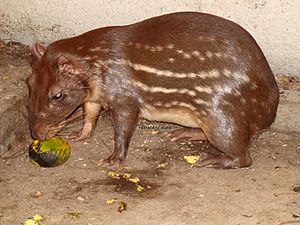Paka
| Paka | ||||||||||||
|---|---|---|---|---|---|---|---|---|---|---|---|---|

Paka ( Cuniculus paca ) |
||||||||||||
| Systematics | ||||||||||||
|
||||||||||||
| Scientific name | ||||||||||||
| Cuniculus paca | ||||||||||||
| ( Linnaeus , 1766) |
The Paka ( Cuniculus paca ) is a rodent species from the genus of the Pakas ( Cuniculus ) within the suborder of the guinea pig relatives .
Appearance
Along with capybara and pakarana, the pak is one of the largest rodents in South America. Particularly striking is the robust body, which is also reminiscent of that of capybaras and is characterized by the curved head, the arched back as known from Agoutis, and the short limbs. The ears are flesh-colored and triangular in shape. The volume of the elongated, curved cheekbone forms two cheek pouches on the sides. During the night the lowland paka can orient itself well with the long whisker hairs and the existing tapetum lucidum , the reflective layer behind the retina, which causes better visual performance. The head body length is 60 to 80 centimeters, the tail length 3 to 4 centimeters, the shoulder height about 35 centimeters and the weight between 6 and 12 kilograms. The short fur is brownish-red to gray, colored yellowish-white below and in the snout region. On the side of the flanks, irregularly blurred lines of spots can be seen, which are particularly pronounced in young animals. The front legs have 4, the rear legs 5 strong claws, which are particularly good for digging.
distribution
The Paka lives in South America east of the Andes as well as in tropical and subtropical areas of Central America .
Way of life
Pakas live in monogamous couples but prefer to roam alone. The couples' territories are 2 to 3 hectares in size. During the day they doze together or individually in hollow tree stumps, under exposed roots or self-dug, shallow structures up to 9 meters long with several exits. Smells play an important role in Paka's life. An interaction between couples is the mutual spraying of urine, which presumably is supposed to transmit the body's own odor and thus the tolerance between both partners is given. Pakas with a strange smell are attacked by couples and driven out of the area. Pakas can swim well from the first day of life and often flee into the water in case of danger. In addition, when there is danger, Pakas grind their teeth intensively to deter their attacker. At night they go looking for food. Like agoutis, they use fixed walkways for orientation. Pakas are mainly frugivorous and the wide range of foods is made up of various seeds, leaves, shoots, roots, stems and tubers. Pakas are unpopular with farmers because they cause considerable crop damage in many regions.
Reproduction
The breeding season is not always seasonal. Up to three litters are born throughout the year. The high season of birth is reached in March and August through September. Paka cubs are born in the Yucatan during the dry winter and spring months. After a gestation period of 114 to 119 days, one or two cubs are born whose birth weight is between 500 and 700 grams. The male remains in the presence of the mother and her young during the young rearing period. The young are born well developed - eyes and ears are open. In the first few days they stay in the mother's nest, from the third day onwards they go on their first excursions together with the mother and eat the first food. Development is rapid and by 6 weeks of age they are weaned. The more they distance themselves from the mother and begin to “produce” their own fragrance, the less the boys are respected by their parents. The young are sexually mature at around 9 to 12 months.
Hazardous situation and protective measures
The Pakas are listed on the Red List of Endangered Species of the International Union for Conservation of Nature IUCN . Due to the widespread distribution, the assumed large population and the occurrence in some protected areas, the IUCN assesses the species as Least Concern , even if local extinction events occur.
The Paka is listed in Appendix III of the Washington Convention on CITES at the instigation of Honduras, which means that international trade in specimens from this country is subject to certain restrictions.
consumption
In Ecuador in particular , the meat of the Pakas (Ecuatorian Spanish: Guantas) has long been considered a high-quality delicacy - even if consumption was never as widespread as that of Cuy (guinea pigs), for example . For a number of years the hunting of pakas and the sale of the meat has been banned and sellers who sell the meat illegally are accordingly prosecuted.
Web links
- INBio: Especies de Costa Rica - in Spanish
- UNEP-WCMC Species Database. Retrieved March 15, 2010 (English, data from Cuniculus paca ).
Individual evidence
- ↑ cuniculus paca in the endangered Red List species the IUCN 2010. Posted by: Queirolo, D., Vieira, E., Emmons, L. & Samudio, R., 2008. Accessed on March 15 of 2010.
- ^ The CITES Appendices. CITES Convention on International Trade in Endangered Species of Wild Fauna and Flora, May 22, 2009, accessed March 15, 2010 (English, search for Cuniculus paca ).
- ↑ La Hora: Cuidado con vender carne de guanta: http://lahora.com.ec/index.php/noticias/show/1101524956#.VqYuB1IXaWw